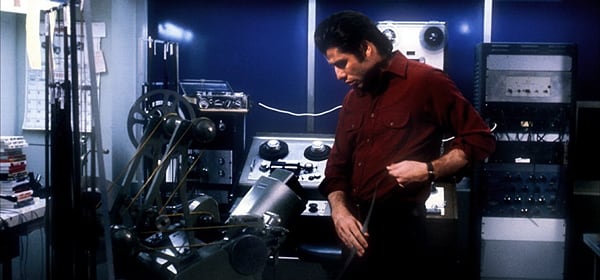
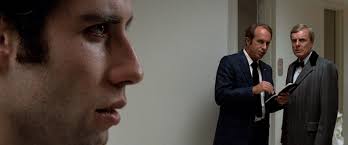
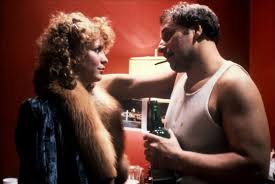
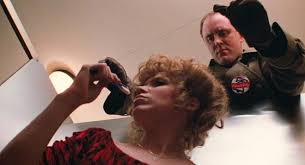
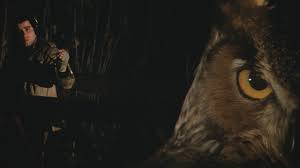


Brian De Palma was the undisputed king of thrillers in his heyday, with a run of hits, classics and near-misses that began with “Carrie” and ended when his take on Tom Wolfe’s “Bonfire of the Vanities” became one of the greatest flops of its era.
But “Carrie,” “The Fury” and “Dressed to Kill,” “Scarface,” “The Untouchables” and “Casualties of War” was a spectacular run of critically-acclaimed successes. A filmmaker who cultivated a “New Hitchhock” reputation by paying showy homage to the master had most film fans ready to name him the replacement “Master of Suspense.”
“Blow Out” (1981) was a rare box office failure in the middle of that run, with audiences perhaps not inclined to take star John Travolta that seriously — yet — and slow to connect to a movie with hints of The Kennedy Assassination, Chappaquiddick and Watergate in its plotting.
The nods to Hitchcock were still there. But here, he’s more directly borrowing from Michelangelo Antonioni’s “Blow Up,” a ’60s New Wave thriller about a photographer who accidentally captures a murder in the background of a snapshot in the park.
Reviews were decent at the time of release, but in recent years “Blow Out” — about a horror movie soundman who captures audio of a political assassination via a sniper shooting out a politician’s tire — has come to be regarded as perhaps De Palma’s masterpiece.
As I originally saw it as a college student all about public radio and “getting great nat (natural) analog sound,” it’s always been my favorite. Seen now, with its retro technology of celluloid “film” and audio recorded via NAGRA portable reel-to-reel recorders on quarter inch magnetic tape, which was then sliced with razor blades and spliced onto mix tapes for a sound track, it’s an adoring relic for a near forgotten craft.
I remember being dazzled back then. I don’t know if it tops “Dressed to Kill (1980)” or the cultishly adored “Scarface (1983).” But it’s decently-acted, tough, stylish and pitiless, and stands out for a lot more than its pioneering Steadicam (hand-held heavy 35mm film cameras) and famed two minute “360 degree pan” of an editing lab as Travolta’s character frantically searches for “evidence” that has been “magnetically” erased.
Travolta is Jack Terry, a soundman in the horror B-movie market in Philadelphia, a cynic who is sent in search of a more perfect “scream” by his longtime director, and for “fresh” sound effects of wind and the like.
That’s how he’s under that bridge late at night, with its riverside walkway, taping wind and owls and frogs and canoodling lovers. That’s where his all-hearing (exaggerated) “shotgun mike” picks up the sound of a rifle shot just before a sedan blows a tires and careens into the river.
Jack tries to rescue the driver, but finds only a woman (Nancy Allen), gasping for breath as the car sinks. Jack saves her. But in the hospital, this simple heroic act is overshadowed by the dead driver of the car.
“That stiff on the stretcher was probably the next president of the United States!”
Jack comforts the sedated Sally (Allen), and then finds himself strong-armed by the aid (John McMartin) of the dead governor and rival to an unpopular president. The girl “was never there.” Jack won’t “talk.” Etc.
But with her cloud of curls and kewpie doll voice, Sally is irrestible to Jack. As he tries to connect with her, their pact of silence comes under question. The cops and politicos might be willing to hush this all up. The shooter (John Lithgow at his most menacing)? He’s sure to be fretting over “loose ends.”
De Palma allegedly based this James Bond wannabe on Nixon’s aid G. Gordon Liddy, and Lithgow oozes menace and an almost mechanical, on-the-spectrum idea of tidiness. He will kill a few women (starting with the accidental murder of the wrong person), convince the media there’s a “Liberty Bell” serial killer on the loose, and get around to Sally. Eventually.
Jack? He’s smart enough to see the rising threat level and the dangers of anonymity and keeping the story quiet.
The twists are more conventional than Michael Caine in a dress (“Dressed to Kill”), with Dennis Franz as a sleazy private eye, John Aquino as a lazy, paid-to-be-disinterested cop. Jack’s flashback-told back story includes a stretch working — via secret recordings — to help catch crooked cops.
Travolta and Allen, who was married to De Palma at the time, reteam for the first time since “Carrie” to good effect, even if Allen’s character is pretty much a caricature of a “dim” Debby.
The set-pieces they’re hurled through, a Jeep chase through a parade, a mad dash to save a wired-for-sound Sally from the assassin, still pop.
But what blew young film fans away back in the day is the same thing cinephiles still embrace about this homage to Antonioni and Analog. The film’s technique is packed with sizzle, from those hand-held sequences and 360 pans to split screens and split focus (diopter lens) capturing an actor in the background or forground, and something caught in extreme close-up in the other half of the lens-captured image.
Film buffs are often techno nerds, diving into how Kubrick did this, Lucas did that or Hitchcock managed his effects in a simpler “in camera” or “practical” effects era. We went nuts over “Blow Out” when it came out, with or without the fun, inside-film-fandom “Blow Up” connection.
But rewatching it after many years, I had my own flashbacks about my initial reaction. The picture explodes out of the gate, starts to slow as the conspiracy becomes obvious, and peaks at the one hour mark, where that famous 360 degree circling pan turns up.
Everything between there and the Big Finish is relatively forgettable, low-heat “unraveling the plot” exposition and the like.
“Blow Out” is still great, still a classic and still has a bit of the sizzle it came into the world with. But as a pulse-pounding picture, De Palma lets the air out of that tire too soon, and takes a little too long to pump it back in.
Rating: R, graphic violence, sex, nudity, profanity, smoking
Cast: John Travolta, Nancy Allen, John Lithgow, Dennis Franz, John Aquino and John McMartin
Credits: Scripted and directed by Brian De Palma. An MGM release streaming on Tubi, Amazon, et al.
Running time: 1:47


